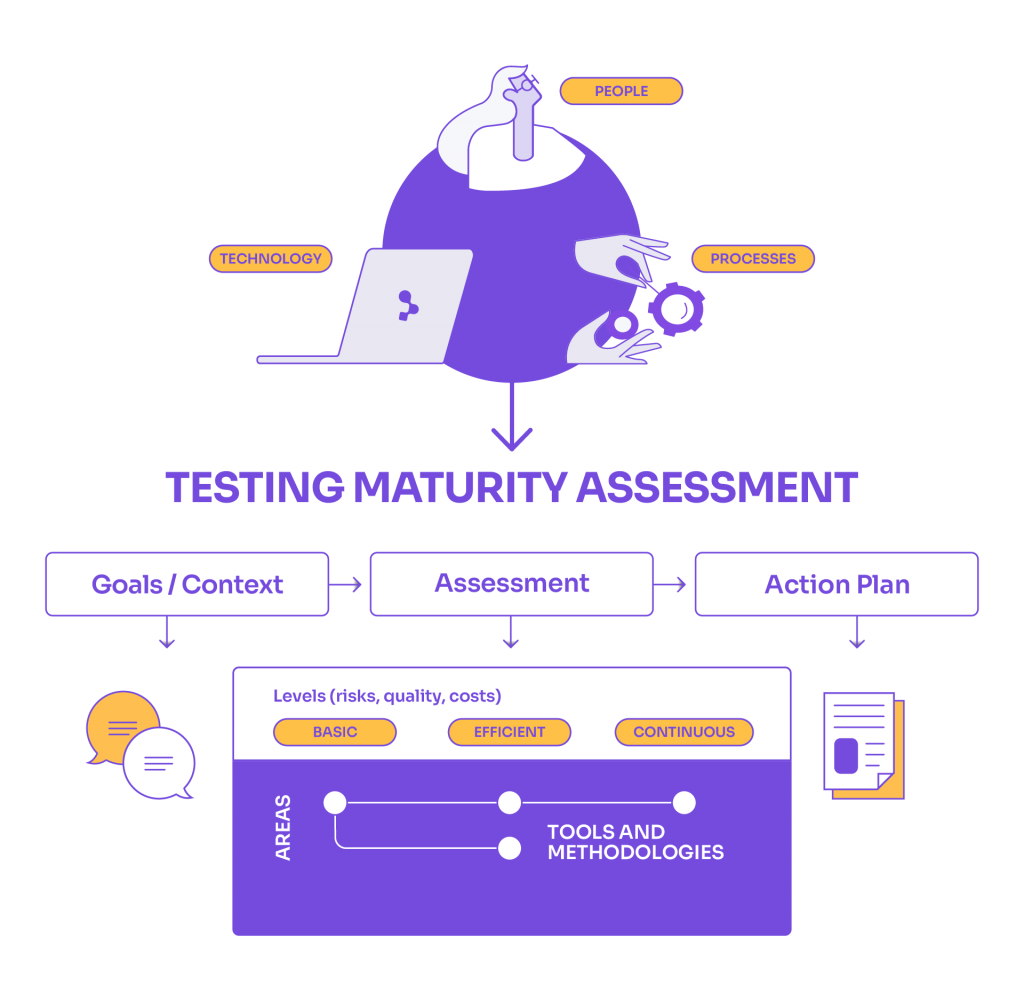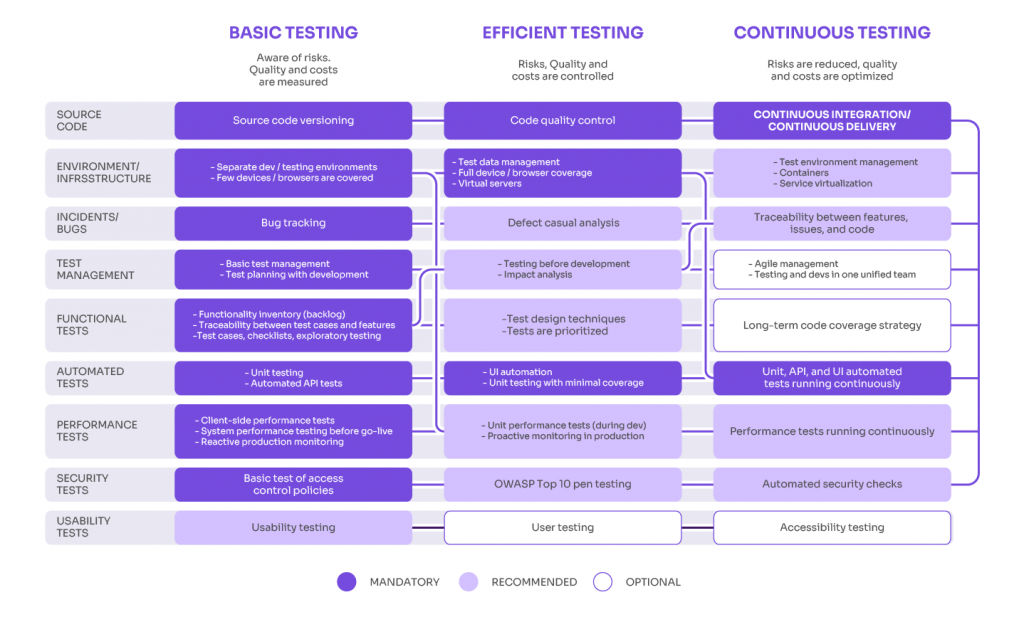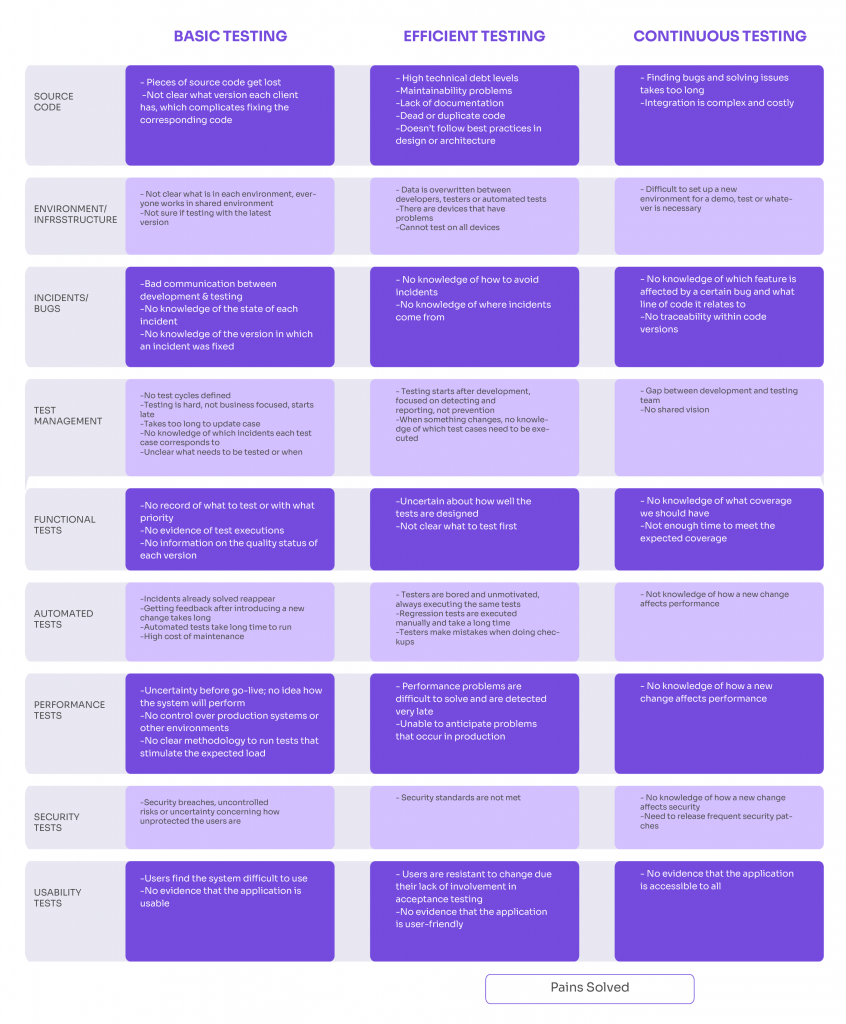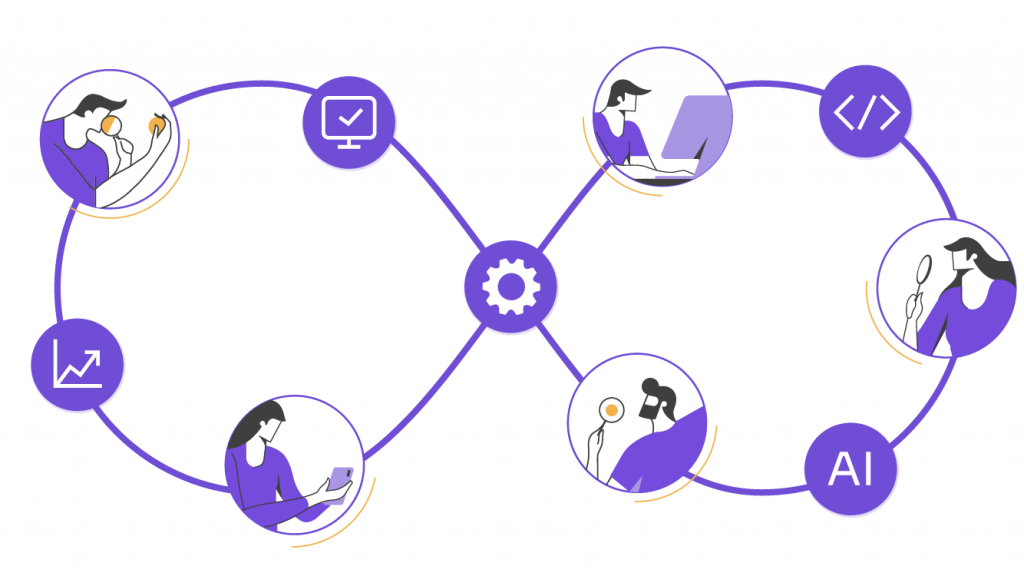A complete guide to assess the effectiveness of your software testing maturity model and see how you can take it to the next level, as part of your software testing process.


Does Your Team Know Where to Focus Next?
Does your development team feel stuck when it comes to knowing what specific things to focus on over different stages of testing phases of the software life cycle (SDLC)? Do you aim to improve your software and achieve test process improvement and quality management? Need to figure out how to fill in the gaps and improve efficiency and results?
We’ve found it immensely valuable to periodically conduct a software testing maturity model (TMM) when working with clients. As part of our software testing process, we also use our proprietary Testing Maturity Assessment during the early stages of a new engagement.
Our goal is to better understand where our client’s team stands in terms of their software quality goals and test processes, to put together a strategy to take them to the next level.
In this post, we’ll share the process behind our software testing maturity assessment so that you can bring some of these ideas to your own test strategy and develop testing further, working towards continuous improvement.
Ready to Reach The Next Level of Software Testing Maturity?
Take our 9-question assessment to find out how your testing stacks up and get custom tips for your software testing strategy.
software testing strategy.
Key Aspects of a Testing Maturity Model
- Business Alignment: Align testing efforts with business risk to maximize value and avoid wasted work.
- Holistic Integration: Blend people, process, and technology so every SDLC stage supports quality smoothly.
- Data-Driven Decisions: Base improvements on clear metrics—defect trends, coverage, and cycle time.
- Strategic Automation: Expand automation deliberately to accelerate feedback, reduce cost, and boost reliability.
- Continuous Improvement: Embed feedback loops that raise maturity and sustain long-term performance.
- Governance & Standardization: Standardize governance and documentation for repeatable, auditable practices.
These six pillars set the stage. Next, we’ll share how our assessment applies to each one and charts a path to higher maturity.
Evolve Your Test Strategy
Our Testing Maturity Assessment measures how effectively your team balances quality, risk, and cost. We map every test activity to its point in the pipeline—from planning to test execution— to expose gaps and spotlight quick wins.
We believe that mature teams are those that have mastered the practice of continuous testing, which is what we’ve designated as our highest level of testing maturity. A continuous improvement approach for your test strategy can help your team succeed, along with the adoption of CI/CD.
Did you know that adapting your testing practices can help you minimize business risk and increase software quality? We invite you to dive into our tailor-made Testing Strategy Services.
In-Depth Testing Maturity Framework
Beyond the quick nine-question quiz, our in-depth Software Testing Maturity Assessment follows the framework below.
Evaluation Overview
Firstly, we conduct the analysis considering the three main pillars of software engineering:
1. People: roles, skills, collaboration
2. Process: SDLC, project management processes, governance, metrics.
3. Technology: tools, environments, automation stack.
Software Testing Maturity Levels
To keep things simple, we’ve defined three different levels of software testing maturity:
When performing the assessment, we follow a three-step process:
- We analyze the team’s context and objectives.
- We carry out the evaluation based on our defined maturity criteria, going over the complete quality and testing strategy.
- We arrive at an action plan that we then suggest putting in place to advance to the next level.
One of the first things to analyze, after understanding the objectives and the context, is the maturity of the team in terms of skills, communication, and other aspects that also influence the quality of the final product.
In the same way, we analyze everything related to the process, methodology (whether the team works in agile, waterfall, or a hybrid environment with an agile mindset).
Putting it all together, we see something like this:


Assessment Areas
Next, we delve into other points that are largely related to the technological and process aspects of software development, but highly focused on everything that affects quality.
Below are the nine testing areas we score in every Software Testing Maturity Assessment:
- Source code
- Environment and infrastructure
- Incidents and bugs
- Test Management
- Functional tests
- Automated tests
- Performance tests
- Security tests
- Usability tests
For each area analysed, we define a three-level maturity table, for which certain preconditions must be met to reach each level.
This leads us directly to the action plan, because it’s clear that certain issues must be addressed first in order to advance to a higher level. Everything is, of course, validated in context, with activities prioritised and weighed against their respective benefits, costs and risk management considerations.


In the chart above, you can see a base model for the different areas we analyze, from how teams manage the source code to usability and testing processes.
Of all the ISO 25010 quality factors, we included only the most common ones that are relevant for most companies, but for each quality factor, we can define levels in a similar way.
For each area, we identify key activities for each level. As you can see, we define precedence between activities. For example, a team can’t claim to have continuous integration if it doesn’t first have a centralized code repository that manages artifact versions.
Associated with this analysis, the following chart shows some of the most common pain points that each level of maturity manages to eliminate or solve:


A Tool to Level Up Your Software Testing
We hope this software testing maturity model can serve as a useful reference when analyzing how to improve your testing strategy.
We’ve found it to be a helpful tool to clarify which are the most important areas to prioritize, what gaps exist in a test strategy, and how to make a plan to reduce risks and optimize quality under controlled costs.
How? Under controlled costs and with full visibility across all the processes involved in quality assurance.
Key Takeaways
- Map your current testing process against a structured maturity model to expose gaps.
- Prioritize improvements that balance software quality, risk reduction, and cost control.
- Adopt continuous testing and CI/CD to reach the highest maturity levels.
- Accelerate the journey from test findings to software release readiness.
- Use data-driven feedback loops for ongoing optimization and defect prevention.
FAQs about Software Testing Maturity Models


What Is the Testing Maturity Model?
A Testing Maturity Model is any benchmark, such as TMM, TMMi, or TPMM, that measures the effectiveness of an organization’s testing practices, identifies gaps, and provides a roadmap for process improvement aligned with business risk and quality goals.
What Is the Test Process Maturity Model?
The Test Process Maturity Model (TPMM) is a structured framework that evaluates how an organization plans, executes, and improves its software testing process across five maturity levels—from Initial to Optimization—covering people, process, and technology.
What Is the Performance Testing Maturity Model?
A performance testing maturity model assesses an organization’s capability to plan, execute, and analyze load, stress, and scalability tests. It highlights gaps in tooling, environment readiness, and metrics, guiding teams toward predictable, data-driven performance engineering.
What Are the Five Levels of Maturity Modelling?
Most maturity frameworks adopt five stages: Initial (ad-hoc), Managed, Defined, Measured, and Optimizing. Each successive level adds standardization, quantitative control, and continuous improvement to reduce risk and enhance product quality.
What Are the Five Levels of Testing Capability Maturity Model (TMM)?
TMM mirrors CMMI with Level 1 Initial, Level 2 Managed, Level 3 Defined, Level 4 Measured, and Level 5 Optimization. Advancing through these levels introduces test-policy definition, integration with development, metrics-driven control, and proactive defect prevention.
What Are The Five Levels Of IT Maturity?
IT maturity commonly progresses through Initial, Managed, Standardized, Predictive, and Optimized stages, reflecting increasing governance, automation, and alignment with enterprise strategy, which in turn lowers project costs and time-to-release.
How We Can Help You


With over 16 years of experience and a global presence, Abstracta is a leading technology solutions company with offices in the United States, Chile, Colombia, and Uruguay. We specialize in software development, AI-driven solutions, and end-to-end software testing services.
Our expertise spans across industries. We believe that actively bonding ties propels us further and helps us enhance our clients’ software. That’s why we’ve built robust partnerships with industry leaders like Microsoft, Datadog, Tricentis, Perforce BlazeMeter, and Saucelabs to provide the latest in cutting-edge technology.
Curious as to which level your team lands for the different areas of quality? So don’t forget to take our free, online software testing maturity assessment!
Check our solutions and boost your test process improvement!




Federico Toledo, Chief Quality Officer at Abstracta
Related Posts
Next Gen Testers Don’t Know Waterfall
How do we reinvent the “old stuff” to make it efficient and useful again? Something that Derk-Jan de Grood commented on in his course after Uruguay’s annual testing conference, TestingUY, which was very interesting to me, is that most of today’s young testers (the…
How to Show Your Tester Some Love this Valentine’s Day
How to show testers some love this Valentine’s Day—and maybe be loved in return, too. This article was originally published on stickyminds.com Great testers are almost as hard to find as a candy conversation heart that isn’t silly. If you’ve got the opportunity to work…
Search
Contents








